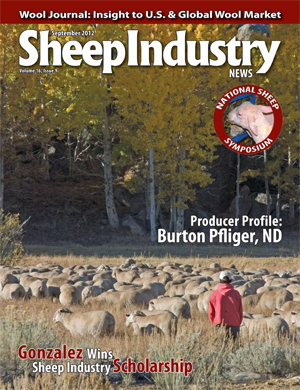
- September 2012
- Lawsuit Filed Against USFS
- Olympic Uniforms to be Made From Oregon Wool
- Additional Lamb Purchase Applauded
- Gonzalez Wins Sheep Industry Scholarship
- Symposium Uses Technology to Attack twoPLUS Initiative
- Pfliger has Sheep Industry Leadership in his Genes
- Solid Leadership Key to Success of NLPA Sheep & Goat Fund
Additional Lamb Purchase Applauded
(Sept. 1, 2012) “The American Sheep Industry Association (ASI) greatly appreciates the U.S. Department of Agriculture’s (USDA) announcement of a $10 million supplemental lamb purchase,” says Association President Margaret Soulen Hinson. “The drought assistance package for livestock producers, including this provision for lamb, is welcome news to help strengthen feeder and slaughter lamb prices.”
“This is significant funding to move surplus product out of the way for the new crop lambs and represents the most efficient way for our industry to get current on supply,” adds Peter Orwick, ASI executive director. “The bottom line of the USDA program is to strengthen the farm-gate price for lambs, which is currently less than half of the 2011 record highs.”
In a release issued in August, USDA announced its intent to purchase up to $170 million of lamb, pork, chicken and catfish for federal food nutrition programs, including food banks. The purchase will help relieve pressure on American livestock producers during the drought, while helping to bring the nation’s meat supply in line with demand and providing high-quality, nutritious food to recipients of USDA’s nutrition programs. Up to $10 million will be used to purchase lamb products, up to $100 million for pork products, up to $10 million for catfish products and up to $50 million for chicken products.
“This purchase is in addition to the hundreds of thousands of pounds of lamb leg roasts and shoulder chops awarded to processors earlier this year for September delivery. There is also a $400,000 invitation open for bid,” says Soulen Hinson. “The $10 million in purchases to be bid is intended to reduce lambs in the lots as well as product inventory in the cooler, which we believe is critical to halt the slide in lamb values and improve prices to producers.”
Orwick concludes, “This funding shows USDA is as aggressive in providing drought aid as they can be while the agriculture industry seeks re-authorization of disaster provisions via Congress, such as the Livestock Forage Program.”

